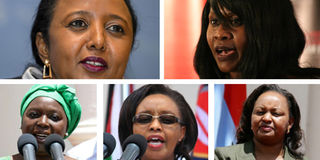Gender balance, public vetting to ensure equity

Top: Amina Mohamed (Foreign Affairs Cabinet Secretary) and Judy Wakhungu (Environment, Water and Natural Resources). Bottom from left: Raychelle Omamo (Defence), Phyllis Kandie (Tourism) and Anne Waiguru (Devolution and Planning).
What you need to know:
- In his first Cabinet, exactly 50 years ago, Uhuru’s father and founding president Mzee Jomo Kenyatta had an all-male 15-member body of ministers.
- By the 1970s there was a trend to give key posts such as provincial commissioners, senior civil servants, security top brass and appointees to statutory bodies to the president’s tribesmen.
- But in 2013, President Uhuru Kenyatta nominated six women into his Cabinet.
In 2013, newly elected President Uhuru Kenyatta nominated six women into his cabinet representing a third of the total ministry heads and observing the Constitutional quota ushered in by the 2010 constitution.
But this wasn’t always so. In his first Cabinet, exactly 50 years ago, Uhuru’s father and founding president Mzee Jomo Kenyatta had an all-male 15-member body of ministers.
Back then, gender equality was not a priority issue with the country still giddy from being unshackled from colonialism.
A casual glance also reveals that although the then Prime Minister Kenyatta did not make the appointments from all Kenyan tribes, there was an attempt to present an ethnic.
The country had emerged from colonialism united but towards the end of the decade, politics of land resettlements as well as political appointments would put a strain on the unity.
In 1966, a Kanu national delegates meeting at the Limuru Conference Centre is seen as a possible starting point towards deteriorating tribal engagements.
The meeting was to ostensibly curb the growing power wielded by the then Kanu Vice-President, the late Jaramogi Oginga Odinga, who was also the President’s second in command.
With time, murmurs started to emerge over perceived marginalisation of some communities with appointments for powerful jobs being seen as mostly reserved for members of the president’s community.
In his book, Kenya: A History Since Independence, author Chris Hornsby says that by the 1970s there was a trend to give key posts such as provincial commissioners, senior civil servants, security top brass and appointees to statutory bodies to the president’s tribesmen and this continued until 1978, the end of the regime and beyond.
Clearly the trend continued in the second president Daniel Moi ‘s era with ethnic calculations seen to feature prominently in appointment, especially those of the sensitive security positions and civil service.
In a dissertation, Wanjiru Nyaguthii and Kamau Rutenberg write that this was seen as an attempt to undercut the power the Kikuyu elite had come to wield.
RADIO DISMISSALS
This was best illustrated by in the appointments after the 1993 General Election, where the Kikuyu and Luo communities, which had overwhelmingly voted for the opposition were only given one representative each in the 25-strong cabinet.
Dismissals from such positions were also fairly dramatic. It was not uncommon for a minister’s dismissal to be announced over the radio broadcast news without having been earlier informed.
In his biography launched last year, former Kenya Commercial Bank Chief Executive Martin Oduor-Otieno recalled how news came to them that the Dream Team had been disbanded on the 1pm KBC news broadcast.
The team of six had been appointed to try restoring sanity to a struggling economy in 1999, but two years down the line, it was clear their talents would be wasted on the republic. Politics usually had a way of prematurely ending terms for those without very powerful friends.
After the 2002 elections, the scales were then seen to be tilting towards some ethnic communities and this was accelerated by a falling out of the country’s leadership after the 2005 Constitution referendum.
This was reaffirmed by a civil service audit carried out in 2010 by the National Cohesion and Integration Commission (NCIC) which showed that Kikuyus held 22.3 per cent of all civil service jobs, followed by the Kalenjin (16.7 per cent).
Then head of NCIC, Mzalendo Kibunjia said the numbers suggested a direct relationship with the tenure of the presidency, in that the two communities had had a member as president in the over 20 post-independence years.
But even with the tribe element dictating who got appointed where, there was an even worse disparity in gender.
Between 1963 and 2002, only two women had held a minister’s position with the first being Nyiva Mwendwa, who was appointed the Minister for Culture and Social Services after the 1992 election. This was 29 years after independence.
With the coming to power of President Mwai Kibaki in 2002, more women would get representation in the cabinet. This was, however, more on political grounds rather than clamour for equality in appointments.
For decades, women lobbied for affirmative action legislation but this only came into fruition in 2010 with the Constitution.


